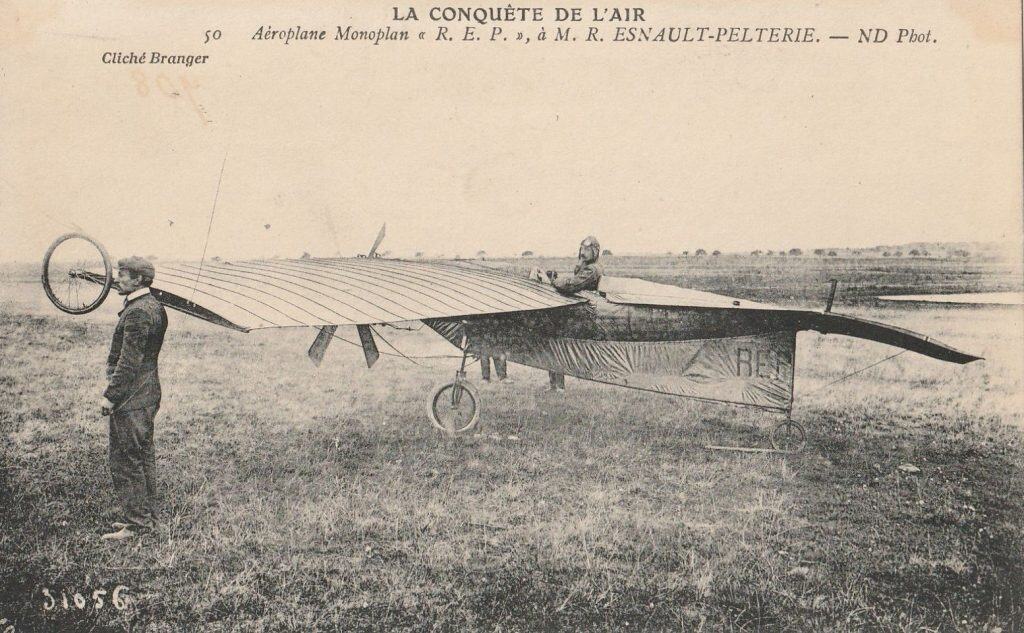Bob Teevan
The REP, an Early Airplane

This card is titled “La Conquête De L’Air. Aeroplane Monoplan ‘R.E.P.’, a M.R. Esnault-Pelterie.” This probably needs little by way of translation and is an image of a single winged aircraft and a gentleman named Robert Esnault-Pelterie.
From an Internet biography, we learn that Robert Esnault-Pelterie (1881 – 1957) was a French aircraft designer and spaceflight theorist. He is referred to as being one of the founders of modern rocketry and astronautics, along with the Russian Konstantin Tsiolkovsky, the Germans Hermann Oberth, Fritz von Opel, Wernher Von Braun and the American Robert H. Goddard.
The primitive appearance of the aircraft is fascinating. It appears to be constructed of wood or thin metal rods and covered with canvas. Both the wings and the tail seem to be of considerable size, but the design is insufficient for the aircraft to stand independently. It has a wheel under the body and a smaller wheel under the tail. The wheels are not set in pairs, and it seems that the aircraft is only standing upright because someone on the right side is holding it in position for the photographer. It is easy to suggest that the bicycle wheel on the wing was intended to prevent damage to the wing when landing.
The careful observer will notice that Robert Esnault-Pelterie’s initials are painted on the canvas at the back of the craft. Apparently he made his first flight in the spring of 1907 at his own Aerodrome Toussus-le-Noble (Seine et Oise). He held French Pilot License number 4 (1908). He was among the best known early French aircraft designers and had several other inventions to his credit.
On October 10, 1907, Esnault-Pelterie flew his first powered plane, the REP 1, which was capable of staggering into the air for brief stints. But he is better remembered for his innovations and inventions, such as his “joystick” meant to function as an aircraft control. This innovation would pit him against his fellow contemporary Frenchman, Louis Bleriot, the inventor of cloche controls.
***
No history of early aviation would be complete without mention of the fierce competition between the French pioneers and the Wright Brothers. One such examination of that rivalry explains, The French were more than a little sniffy of American claims to have pioneered aviation. France had led the world in manned flight since the first crossing of the English Channel by hot-air balloon in 1785. It was only logical that the French would be the first to fly aeroplanes.
Consequently, in October 1908, the Aéro-Club de France was founded as a society to encourage aerial locomotion. Their primary goal was to make it happen in France.
[From a casual point-of-view, the formation of the Aéro-Club de France was very much akin to slamming the door on an already achieved goal.]
In December 1903, the Wright Brothers ruined it all, when the wheels of the Wright Flyer left the ground at Kitty Hawk, North Carolina, in the first controlled flight of an airplane. Or so the American brothers had boasted.
The French press was having none of it. The Wright Brothers were either “flyers or liars,” read one editorial in 1906. (In French the accusation would have been “flyers ou menteurs.” It loses its rhythmic note, but the insult remains.) In their world everything was still very much in play at least as far as the Aéro-Club was concerned.
Two of its founders, Ernest Archdeacon, a lawyer of Irish descent with money to burn, and Henri Deutsch de la Meurthe, the so-called “oil king of Europe,” established the Grand Prix d’Aviation to spur on French aviation.
The Deutsch-Archdeacon Prize, as it became known, of 50,000 francs would be awarded to whoever could fly one kilometer in a circular course. And if it was so easy for the Wright Brothers, then surely, they would travel to France and perform the feat without any problem.
But the Wright Brothers responded with open ridicule, preferring instead to concentrate on their business interests. Wilbur Wright referred to Archdeacon as “an ass.” As it happened, the brothers had achieved such a feat in 1904, and had flown 39 kilometers a year later. But the Aéro-Club wasn’t convinced, and the prize still waited for a winner.
And, won it was on 13 January 1908. The 50,000 francs were awarded to Anglo-French pilot Henri Farman, who flew his Voisin aeroplane over the one-kilometer course in one minute and 28 seconds. Feted as a hero, Henri went into business with his brother, Maurice, later founding Lignes Aeriennes Farman.
In 1933, the airline merged with others to become the French national flag carrier, Air France.
Another claimant to the title of “first to fly an airplane” was the Brazilian Alberto Santos-Dumont.
Good research in here! Liked learning hitherto unknown details of the birth of the airplane as a transportation mode.
great post – thank you
Really some great history in this article. Thank you Bob. Old transportation is a great and fun category to collect. For a lot of us guys out here it’s all about the Planes, Trains and Automobiles.